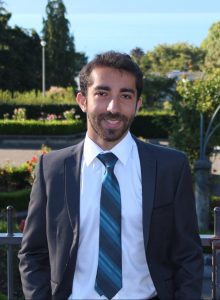Photos courtesy of Sina Maloufi and the Tang Lab

Things aren’t always what they seem at first glance. This is especially true in the field of skin cancer, where even an expert eye can only see skin deep, and an accurate, timely, and minimally invasive diagnosis can make a colossal difference for patient outcome and wellbeing.
That’s precisely what Sina Maloufi and Dr. Shuo Tang’s Biophotonics Group at the Advanced Materials and Process Engineering Laboratory (AMPEL) are trying to fine-tune with one of their latest projects. This Master of Applied Science (M.A.Sc.) student is focusing on dermatological imaging using optical coherence tomography (OCT), which can be thought of as “ultrasound with light.” OCT uses a very low-powered laser and some optical tricks to produce high-quality three-dimensional scans of objects by simply shining a special light source onto that object.
OCT is already widely used by ophthalmologists in the clinic to diagnose retinal diseases such as glaucoma and diabetic retinopathy. However, the Tang Lab hypothesizes that OCT can transform dermatology by allowing physicians to diagnose skin cancers without the need for a biopsy. Other researchers have looked into using OCT for this non-invasive purpose, but Sina and his team have created a system that uses a special type of OCT—Polarization-sensitive OCT (PS-OCT)—that could potentially be better at detecting melanoma compared to traditional OCT.









Sina is working alongside fellow SBME student Daniel Louie to conduct a pilot study on a larger group of healthy volunteers to show that this imaging modality can accurately characterize skin features across a diverse population. Sina’s longer-term goal is to see PS-OCT systems being used in the clinic to aid dermatologists in rapidly diagnosing skin cancers without the need for painful and invasive biopsies.
Sina’s involvement in biomedical engineering stems from a lifelong commitment to transforming health outcomes for more people. He believes that leaders are forward-thinking and selfless; leaders support and empower others to reach their full potential and work towards things that are bigger than themselves alone.
“I’ve been a type 1 diabetic since the age of three, and due to that, I’ve always had a personal appreciation and fascination towards medical technology,” Sina shares. “The specifics may have changed over the years, but I’ve always seen myself ending up in the healthcare field in some capacity. I found that biomedical engineering has allowed me to contribute my part towards healthcare while still allowing room for creativity and independent exploration.”
So far, Sina is making steady progress towards that goal. His lab’s work has been published in the Journal of Biomedical Optics and Biomedical Optics Express, and he has presented his findings so far at SPIE Photonics West, one of the largest photonics research conferences in the world.
Beyond his research, Sina unwinds with music. He plays the guitar and performs with artists, and that passion has taken him across the globe on an eastern European tour with singer-songwriter Gert Taberner.
This story is part of the SBME’s Building Today, Leading Tomorrow series. Follow along as we Discover, Invent, and Translate for the future.
